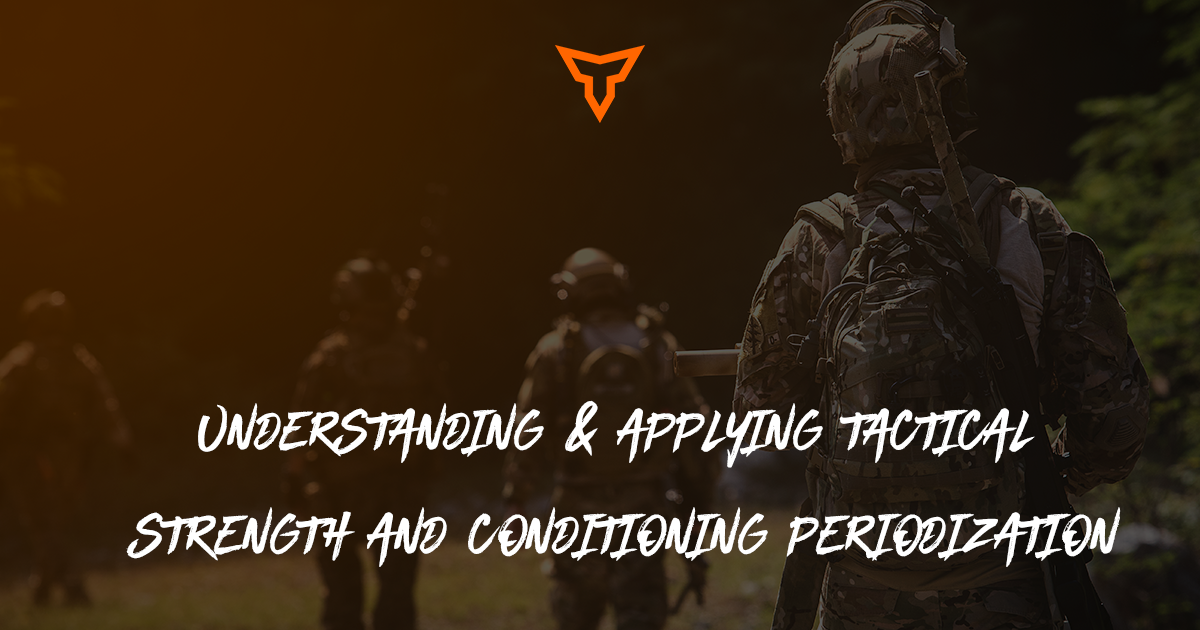Modifying the Conjugate Method for Tactical Athletes
Introduction to the Conjugate Method:
The conjugate method is a popular strength and conditioning training system that emphasizes training multiple physical qualities concurrently. It involves rotating through a variety of exercises and training modalities that target different aspects of strength, such as maximal strength, explosive power, and muscular endurance. The main key to the conjugate method is to constantly vary the exercises and loads, to avoid plateauing and keep the athlete progressing towards their goals. This method has been used successfully in powerlifting, Olympic weightlifting, and other intermittent sports that require higher levels of strength and power.
TSAC Differences:
In the tactical setting, there is no true “off season” unless you are working with a training school or within a controlled pipeline. However, the conjugate method can be very good for assisting in overcoming these problems assuming consistent training is a mandatory requirement of the department or squadron the TSAC serves. However, the coach should consider the following while programming:
- Is there a lack of recovery (Sleep, proper nutrition, etc.)
- How can the coach intensify methods?
- Is the program adaptable for an older veteran as opposed to a new rookie?
- Do operational tempos or shifts change?
- What is the current status of training tenure amongst the coach’s population?
Once you answer the following questions above, understanding a basic conjugate outline will assist in the coach’s proper preparation of building up a TSAC program. Note: The outline below has been used within the communities I serve now and has produced amazing results.
12-Week Outline 5 Day Variation
Phase #1
4 Weeks
|
Day 1 |
Day 2 |
Day 3 |
Day 4 |
Day 5 |
Day 6 |
Day 7 |
|
Submax Effort Upper |
Unilateral Repeated Effort Lower |
Aerobic Conditioning Long Slow Distance |
Unilateral Repeated Effort Upper |
Submax Effort Lower |
Aerobic Conditioning Long Slow Distance |
FULL REST |
|
Repeated Effort |
Strongman Endurance AMRAP or Repeated Effort (12-20 reps) |
Rehab/Prehab/ Work |
Strongman Endurance AMRAP or Repeated Effort (12-20 reps) |
Repeated Effort |
Rehab/Prehab/ Work |
|
|
ATP-PC Power Work |
Anaerobic Cardiac Intervals |
|
Anaerobic Cardiac Intervals |
ATP-PC Power Work |
|
|
|
|
|
|
|
|
|
|
Phase #2
4 Weeks Notes:
- Submax day’s accessory repeated effort should still have a unilateral focus
- Pick two dynamic effort exercises and switch every two weeks, increase volume prior to load. Do not make it the same as the primary lift on submaximal effort days. See the example below:
Example:
Wk 1 - 45-Degree Incline Bench
Wk 2 - Bench
Wk 3 - 45-Degree Incline Bench
Wk 4 - Bench
|
Day 1 |
Day 2 |
Day 3 |
Day 4 |
Day 5 |
Day 6 |
Day 7 |
|
Submax Effort Upper |
Dynamic Effort Lower |
Aerobic Conditioning Long Slow Distance |
Dynamic Effort Upper |
Submax Effort Lower |
Aerobic Conditioning Long Slow Distance |
FULL REST |
|
Repeated Effort (6-8 reps) |
Strongman Endurance AMRAP or Repeated Effort (8-12 reps) |
Rehab/Prehab/ Work |
Strongman Endurance AMRAP or Repeated Effort (8-12 reps) |
Repeated Effort (6-8 reps) |
Rehab/Prehab/ Work |
|
|
ATP-PC Power Work |
Anaerobic Cardiac Intervals or Anaerobic Time Trial |
Anaerobic Cardiac Intervals or Anaerobic Time Trial |
ATP-PC Power Work |
Phase #3
4 Weeks
- Maximal Effort Days rotate the primary movements every week
- Repeated Effort Movements will have a higher loading focus than the previous phase on both max effort & dynamic effort days. Still have unilateral focus if need be
- Rotate Dynamic Movements the same as Phase 2
- De-load 4th week or repeat 1st week of phase.
|
Day 1 |
Day 2 |
Day 3 |
Day 4 |
Day 5 |
Day 6 |
Day 7 |
|
Max Effort Upper |
Dynamic Effort Lower |
Aerobic Conditioning Long Slow Distance |
Dynamic Effort Upper |
Max Effort Lower |
Aerobic Conditioning Long Slow Distance |
FULL REST |
|
Repeated Effort (4-6 reps) |
Repeated Effort (6-8 reps) |
Rehab/Prehab/ Work |
Repeated Effort (6-8 reps) |
Repeated Effort (4-6 reps) |
Rehab/Prehab/ Work |
|
|
ATP-PC Power Work |
Anaerobic Cardiac Intervals or Anaerobic Time Trial |
Anaerobic Cardiac Intervals or Anaerobic Time Trial |
ATP-PC Power Work |
Phase #4
- Maximal Effort Days rotate the primary movements every week
- Repeated Effort Movements will have a higher loading focus than the previous phase on both max effort & dynamic effort days. Still have unilateral focus if need be
- Add chains or bands to both dynamic effort and maximal effort as needed
- Rotate Dynamic Movements the same as Phase 3
- De-load 4th week or repeat 1st week of phase.
|
Day 1 |
Day 2 |
Day 3 |
Day 4 |
Day 5 |
Day 6 |
Day 7 |
|
Max Effort Upper |
Dynamic Effort Lower |
Aerobic Conditioning Long Slow Distance |
Dynamic Effort Upper |
Max Effort Lower |
Aerobic Conditioning Long Slow Distance |
FULL REST |
|
Repeated Effort (4-6 reps) |
Repeated Effort (6-8 reps) |
Rehab/Prehab/ Work |
Repeated Effort (6-8 reps) |
Repeated Effort (4-6 reps) |
Rehab/Prehab/ Work |
|
|
ATP-PC Power Work |
Anaerobic Cardiac Intervals or Anaerobic Time Trial |
Anaerobic Cardiac Intervals or Anaerobic Time Trial |
ATP-PC Power Work |
Coach’s note: Factors the coach should consider for building up a voluntary program as opposed to a mandatory program.
Q: What frequency can the athlete make time for a week to week?
A: A great way to counteract the “frequency per week” dilemma that coaches encounter is to have 3- & 2-Day variations of each week planned based on the 5 Day per week program. This tends to be beneficial if operational tempo increases and more training outside of the human performance realm is required.
Q: How much time does the athlete have within each session?
A: To assist in solving this common hurdle that coaches encounter: divide the session into 20, 40, and 60-minute blocks. As the practitioner; figure out which movements, supersets, repeated efforts, and conditioning emphasis will be best suited per 4-week mesocycle written.
Q: Would moving the recovery day around serve the athlete better?
A: Building off question number 1, sometimes recovery is better for the athlete if the operational tempo and schedule change last second. It is important to have built a good relationship with the tactical athlete so trust is built. This will assist in the long run with issues that arise and presenting different recovery modalities since recovery is not something commonly emphasized within these communities.
Q: What is the athlete’s previous injury history & what modifications are needed?
A: Building off the trust mentioned in question 3, the athlete must feel safe discussing injuries with the practitioner. This is incredibly important if injured personnel have any sort of social burden on the unit or command.
Conclusion:
In summary, the conjugate method is a highly effective strength and conditioning training system that emphasizes training multiple physical qualities concurrently. This method has been successfully used in powerlifting, Olympic weightlifting, and other intermittent sports that require high levels of strength and power. However, in a tactical setting, where there is no true "offseason," the coach must consider various factors when programming the conjugate method, such as lack of recovery, intensification methods, adaptability for different populations, operational tempo changes, and training tenure.
Additionally, building a voluntary program requires consideration of the athlete's availability, session time, recovery, and injury history. Overall, implementing the conjugate method with careful programming and adjustments can assist tactical athletes in achieving their strength and conditioning goals. As always please feel free to take my work and build off of it.
Subscribe to our blog
Subscribe to receive the latest blog posts to your inbox every week.
Related posts

Understanding & Applying Tactical Strength and Conditioning Periodization

My Journey to Tactical: Comparisons to the College Sector

